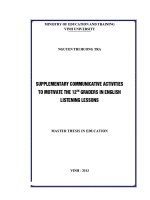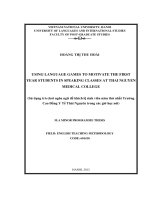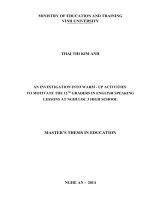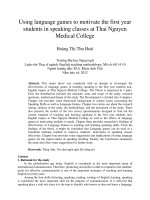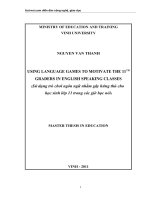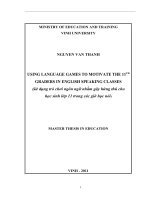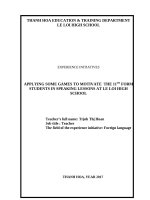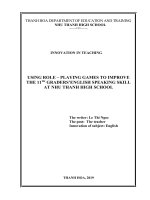SING LANGUAGE GAMES TO MOTIVATE THE 11TH GRADERS IN ENGLISH SPEAKING CLASSES
Bạn đang xem bản rút gọn của tài liệu. Xem và tải ngay bản đầy đủ của tài liệu tại đây (552.79 KB, 86 trang )
Ket-noi.com diễn đàn công nghệ, giáo dục
MINISTRY OF EDUCATION AND TRAINING
VINH UNIVERSITY
NGUYEN VAN THANH
USING LANGUAGE GAMES TO MOTIVATE THE 11TH
GRADERS IN ENGLISH SPEAKING CLASSES
(Sử
dụng trò chơi ngôn ngữ nhằm gây hứng thú cho
học sinh lớp 11 trong các giờ học nói)
MASTER THESIS IN EDUCATION
VINH - 2011
1
Ket-noi.com diễn đàn công nghệ, giáo dục
MINISTRY OF EDUCATION AND TRAINING
VINH UNIVERSITY
NGUYEN VAN THANH
USING LANGUAGE GAMES TO MOTIVATE THE 11TH
GRADERS IN ENGLISH SPEAKING CLASSES
(Sử
dụng trò chơi ngôn ngữ nhằm gây hứng thú cho
học sinh lớp 11 trong các giờ học nói)
FIELD: THEORY AND METHODOLOGY OF ENGLISH LANGUAGE TEACHING
CODE: 60.14.10
MASTER THESIS IN EDUCATION
VINH - 2011
2
Ket-noi.com diễn đàn công nghệ, giáo dục
STATEMENT OF AUTHORSHIP
I certify that the minor thesis entitled “Using language games to motivate the
11th graders in English speaking classes ” is the result of my own work, and that the
minor thesis or any part of the same has not been submitted to any university or
institution.
Vinh, September 2011
Author’s signature
Nguyễn Văn Thành
3
Ket-noi.com diễn đàn công nghệ, giáo dục
ACKNOWLEDGEMENTS
I would like to acknowlede with all my greatest attitude the support,
guidance and invaluable critical feedback which I have received from
my
supervisorMr Ngo Dinh Phuong.
`My sincere thanks are due to the teachers and students at Ha Huy Tap high
school where I have been teaching in and gather information for my study. Without
their help, this study could not have been successful.
I am also indebt of my lectures, my friends, my classmates, as well as my
colleagues for their invaluable comments, criticism and encouragement.
Last but not at least, I would like to express my deepest gratitude to my
beloved people , my parents, my wife, and my daughter for their love , care,
tolerance, and encouragement.
4
Ket-noi.com diễn đàn công nghệ, giáo dục
ABSTRRACT
Speaking always plays an important part in teaching and learning English.
However, How to motivate students to speaking English in classroom is not simple.
In order to improve the quality of speaking classes, the study limits itself to the
study on using language games to motivate the 11th graders to speak.
The study has been conducted for the purpose of testing the effectiveness of
using language games to motivate students at Ha Huy Tap high school in speaking
classes. Thus, two sets of survey questionnaire including pre-task survey
questionnaire and post-task survey questionnaire are used to investigate students’
attitudes, perspectives towards speaking skill and language games adapted during
speaking lessons, to find out the students’ preferences for employing this technique
in mastering speaking skill.
The study consists of five chapters. Chapter I presents the factors as the plan
of the study such as: aims, scope, methods as well as the design of the study.
Chaper II named Literature Review is the display of theoretical background. The
next chapter , Research Methodology is the presentation of the hypothesis, subject
of the study, the textbook and data collection. Chapter IV is one of the most
important chapters in the study deals with the collected data, and to infer some
suggestions on using language games, which are presented in the last chapter.
5
Ket-noi.com diễn đàn công nghệ, giáo dục
TABLE OF CONTENTS
TABLE OF CONTENTS.....................................................................................................6
CHAPTER I: INTRODUCTION.......................................................................................8
1.1. Rationale......................................................................................................................8
1.2.Aims of study...............................................................................................................9
1.3. Scope of the study.......................................................................................................9
1.4. Research questions......................................................................................................9
1.5. Methods.......................................................................................................................9
1.6. Organization of the study..........................................................................................10
CHAPTER II. LITERATURE REVIEW.......................................................................11
2.1. Communicative language teaching...........................................................................11
2.1.1. Definitions of CLT.............................................................................................12
2.1.2. Characteristics of CLT.......................................................................................12
2.1.3. Principles of CLT...............................................................................................13
2.2. Speaking....................................................................................................................17
2.2.1.Definitions of speaking.......................................................................................17
2.2.2. The importance of speaking...............................................................................17
2.2.3. Phrases to teach speaking...................................................................................17
2.2.4. Common speaking activities..............................................................................19
2.3. Motivation.................................................................................................................21
2.3.1. Definitions of motivation...................................................................................21
2.3.2. Types of motivation............................................................................................22
2.3.2.1. Integrative and instrumental motivation......................................................23
2.3.2.2. Intrinsic and Extrinsic motivation...............................................................25
2.3.2.3. Resultative motivation.................................................................................26
2.3.3 The role of motivation in foreign language learning...........................................26
2.4. Overview of language games....................................................................................27
2.4.1. What are language games?.................................................................................27
2.4.2. Types of language games..................................................................................28
2.4.3. Produres of games..............................................................................................30
2.4.4. Opinions on using games in teaching and learning process...............................31
2.4.5. Why use games in language teaching.................................................................33
2.4.6. When to use games.............................................................................................34
2.4.7.Language games as a motivator for students to speak........................................35
CHAPTER III. RESEARCH METHODOLOGY..........................................................37
3.1. Background to the study............................................................................................37
3.1.1. Hypothesis..........................................................................................................37
3.1.2. Subject of the study............................................................................................37
3.1.3. The textbook.......................................................................................................37
3.2. Research questions....................................................................................................38
3.3. The instruments.........................................................................................................38
3.4. Data collection...........................................................................................................39
3.4.1. The data collection instrument...........................................................................39
3.4.2. Procedures and methods of data collection........................................................39
6
Ket-noi.com diễn đàn công nghệ, giáo dục
CHAPTER IV. FINDINGS AND DISCUSSION............................................................40
4.1. Presentation and analysis of data...............................................................................40
4.1.1. Pre-task questionnaire........................................................................................40
4.1.1.1. Presentation of the data...............................................................................40
4.1.2. Post-task questionnaire.......................................................................................51
4.1.2.1. Presentation of the data collected from post- task questionnaire................51
4.1.2.2. Data analysis................................................................................................51
4.2. Descriptions of types of games used the class..........................................................58
4.2.1. Finding from the questionaires...........................................................................58
4.2.2. Positive factors...................................................................................................59
4.2.3. Challenges..........................................................................................................60
4.2.4. Sub - conclusion.................................................................................................61
4.3. Some suggestions for using games to motivate students in speaking classes...........61
4.3.1. How games are used?.........................................................................................61
4.3.2. When games are used?.......................................................................................61
4.3.3. How to organize a game?...................................................................................62
4.4. Sample games used in teaching speaking..................................................................64
4.4.1. Warm-ups...........................................................................................................64
4.4..2 Pre-speaking stage..............................................................................................66
4.4.3. While- speaking stage........................................................................................69
4.4.4. Post- speaking stage .........................................................................................72
CHAPTER V: CONCLUSION.........................................................................................74
5.1. Summary of the study................................................................................................74
5.2. Limitations of the study and suggestions for further study.......................................74
REFERENCES...................................................................................................................76
7
Ket-noi.com diễn đàn công nghệ, giáo dục
CHAPTER I: INTRODUCTION
1.1. Rationale
Nowadays, English assumes as a more and more important part as a means
of international communication than ever. Therefore, in some recent years, the
focus of teaching has been promoting oral skills in order to respond to the Students’
needs for effective communication.
However, due to some objective and subjective reasons, teaching and learning
English in general and teaching and learning speaking in particular does not come
up to the study aims. In spite of teachers’ efforts to provide students with
opportunities to develop their communicative skills, how to teach and learn
speaking effectively is still a challenging question to both teachers and students at
many high schools in Vietnam.
At Ha Huy Tap high school, for most students they find speaking especially
important yet most challenging one. It has been proved that some students got into
a habit of learning “mute English” which obviously harmful to a language learner. It
also seems to the writer that the techniques exploited during a speaking activity
such as: role plays, simulations, discussions… are not really effective. Therefore, it
is a necessity to find a supplementary technique used in teaching speaking.
Games can help teachers to create contexts in which the language is useful
and meaningful. It can be realized that the common tendency of these methodology
writers is that teachers should be more active in using classroom activities to help
students recycle lexical items. One of the most recommended activities is games.
According to them, games are highly motivating, competitive and fun. They also
bring a relaxed atmosphere and create more opportunities for students to practise .
With games, students will enjoy themselves, be stimulated and get involved in
speaking. As a result, they can learn new lexical items faster and remember better.
With so many advantages, games seem to be an effective way in teaching and
learning a foreign language in general and speaking.
8
Ket-noi.com diễn đàn công nghệ, giáo dục
All the aboved- metioned reasons and factors have inspired the writer to
conduct a research titled " Using language games to motivate the 11th graders in
English speaking classes ”
1.2.Aims of study
The study is aimed at:
- Investigating the situation of teaching and learning speaking to the 11 th
graders in classroom.
- Investigating the effectiveness of using games in teaching speaking to the
11th graders at Ha Huy Tap high school.
- Providing some suggestions and implications for the improvement of
speaking teaching at Ha huy Tap high school by using games in addition to other
techniques.
1.3. Scope of the study
The study focuses specifically on using games in teaching speaking to the
11th graders at Ha Huy Tap high school in Nghe An. So the study limits itself to the
teaching and learning speaking only, and the subjects of the study are students from
two classes studying “Tieng Anh 11” text book at Ha Huy Tap high school.
1.4. Research questions
With the above objectives, the research questions are:
- How to motivate the students in English speaking lessons?
- How often are games used in teaching English speaking lessons at 11 th
graders in Ha huy Tap high school?
1.5. Methods
In the process of carrying out this study, the survey questionnaire is used to
collect data for the study. The survey questionnaire including pre-task survey
questionnaire and post- task survey questionnaire is for 80 eleventh form students
from two classes of Ha Huy Tap high school.
9
Ket-noi.com diễn đàn công nghệ, giáo dục
1.6. Organization of the study
The thesis consists of five chapters. Chapter I, Introduction, includes rationale
for the study, the aims, methods, scope, and design of the study. Chapter II comes
the second, in which a theoretical background was presented. Chapter III on
research methodology comes next with the responsibility for specifying the factors
for the researcher to collect and process the study data. Following is Chapter IV
namely ‘Findings and Discussion’, in which the data is described and discussed.
Chapter V comes last with the responsibility for the solutions to the weaknesses. A
summary of the findings, the limitations of the study, are also mentioned in the last
chapter.
10
Ket-noi.com diễn đàn công nghệ, giáo dục
CHAPTER II. LITERATURE REVIEW
Theoretical background relative to the topic and surveys of articles, books
and other resources relevant to a particular study topic will be presented. This part
will also provide description , summary, and critical evaluation of each work
quoted.
2.1. Communicative language teaching
The history of language teaching has shown a lot of changes in approaches
and methods, which reflects the recognition of changes in the sort of proficiency
learners need. Teaching a second language used to be aimed at enabling learners to
read and appreciate class of literature. Therefore, any teacher who was able to reach
this aim was thought to be a good teacher (Le, 2004).
Most learners of English nowadays desire to be able to communicate with
others in the language they learn. Parallel with this change in the aims of learning
English, methods of teaching has to be changed. For a long time, many language
teaching methodologists have constantly looked for the most appropriate way to
teach English efficiently. As a result, many language teaching methods and
approaches have come into being such as:
- Grammar-translation method
- The Direct method
- The Audio-lingual method
- The Audio-visual method
- Communicative Language Teaching (CLT).
Mackey (1965) remarks that most of the methods which have ever been
developed still continue to exist in one form or another as each method has its
advantages and disadvantages. For example, grammar-translation method is easy to
11
Ket-noi.com diễn đàn công nghệ, giáo dục
implement and cheap to administer, which makes it still be used in many classroom
situations.
In my thesis, I only focus on Communicative Language Teaching Approach
(CLT) as it is considered the current methodology and one of the most effective
approaches to teach learners to speak in a second language.
2.1.1. Definitions of CLT
So far, CLT has been viewed differently by different authors such as Wilkins
(1972), Nunan (1989), etc. According to Nunan (1989:194), “CLT views language
as a system for the expressions of meaning. Activities involve oral communication,
carrying out meaning tasks and using language, which is meaningful to the learner.
Objectives reflect the needs of the learner including functional skills as well as
linguistic objectives. The learners” role is as a negotiator and integrator. The
teacher”s role is as a facilitator of the communication process”. It is thought that
this definition contains aspects that are common to many other definitions.
Margie S. Berns (1984: 5), an expert in the field of communicative language
teaching, writes in explaining Firth”s view that "language is interaction; it is
interpersonal activity and has a clear relationship with society. In this light,
language study has to look at the use (function) of language in context, both its
linguistic context (what is uttered before and after a given piece of discourse) and
its social, or situational, context (who is speaking, what their social roles are, why
they have come together to speak)" (Ann Galloway. “Communicative Language
Teaching: An Introduction and Sample Activities”. cal.org ).
2.1.2. Characteristics of CLT
The communicative approach can be said to be the product of language
educators and linguists who became dissatisfied with the Audio-lingual and
Grammar-translation, which could not enable learners to communicate in the culture
of the target language. David Nunan (1991) points out five features of CLT:
12
Ket-noi.com diễn đàn công nghệ, giáo dục
- An emphasis on learning to communicate through interaction in the target
language.
- The introduction of authentic texts into the learning situation.
- The provision of opportunities for learners to focus, not only on language
but also on the learning process itself.
- An enhancement of the learner’s own personal experiences as important
contributing elements to classroom learning.
- An attempt to link classroom language learning with language activities
outside the classroom.
These five features are claimed by practitioners of CLT to show that they are
very interested in the needs and desires of their learners as well as the connection
between the language as it is taught in their class and as it is used outside the
classroom. Under this broad umbrella definition, any teaching practice that helps
students develop their communicative competence in an authentic context is
deemed an acceptable and beneficial form of instruction. Thus, in the classroom
CLT often takes the form of pair and group work requiring negotiation and
cooperation between learners, fluency-based activities that encourage learners to
develop their confidence, role-plays in which students practice and develop
language functions, as well as judicious use of grammar and pronunciation focused
activities.
2.1.3. Principles of CLT
Johnson and Morrow (1981) propose a set of five principles of CLT as
criteria to be taken into consideration in developing teaching procedures.
Firstly: Know what you are doing
In real life, people talk to each other because they really want to talk,
otherwise they would be quiet. But people do not talk just for the sake of talking,
they have something to communicate. Therefore, needs and purposes constitute the
nature of communication. Thus, “when organizing communicative activities, we
13
Ket-noi.com diễn đàn công nghệ, giáo dục
will try to ensure that these activities share the characteristics of communication”
(Harmer, 1986: 43).
In class, what is taught should be closely related to what the learner is most
likely to perform in real life communication. The activities should give students a
chance to use language and to learn more about the language through using it.
Johnson and Morrow (1981:61) suggest that : “every lesson should end with the
learner being able to see clearly that he can do something that he could not do at the
beginning, and the “something” is communicatively useful”.
Secondly: The whole is more than the sum of the parts.
In discussing “whole task practice”, Littlewood (1981: 17) cites an example
of learning to swim which “involves not only separate practices of individual
movement - part skills, but also actual attempts to swim short distances - whole task
practice”. Similarly, in language teaching, communicative activities should provide
students with practice in total skills rather than only in part-skills. If they are only
involved in drill or repetition, their objective will be the accuracy of utterance rather
than its content in a meaningful context. For example, they could be able to
manipulate the past tense forms of verbs but could not tell other people what they
did last weekend properly. So the classroom teacher needs to institute a progression
form artificial exercises to real language use, from discrete linguistic objectives to
communicative objectives” (Schutz and Bartz in Savignon 1983).
Students should have opportunities to deal with a variety of language rather
than just a number of grammatical structures, since there is no corresponding oneto-one equivalence between language forms and communicative functions. For
example, the affirmative sentence “He is a good student” could be a statement
conveying the speaker’s preposition, but it could also be a question expressing
doubt.
Thus, “a crucial feature of communicative method will be that it relates with
stretches of language above the sentence level, and operates with real language n
real situations” (Johnson and Morrow 1981: 61).
14
Ket-noi.com diễn đàn công nghệ, giáo dục
Thirdly: The processes are as important as the form.
Whether an activity is viewed as communicative or mechanical depends on
the processes required from the student while doing it. Fulfilling a communicative
exercise involves the student in filling the information gap between the speaker and
the hearer; making a choice from his repertoire of language of to say and how to say
it, and evaluating the feedback from what he has done.
Communicative activities also require the student to decide for himself what
ideas he wants to express and how to express them appropriately in a certain
situation under the pressure of time during the conversation. Exercises such as
drills, repetition, substitution or guided exercises, in which students are controlled
in the use of language do not practice this aspect of communication.
Another process involved in communication is feedback, which tells the
student whether his utterance has been understood as he intended or not, and what
criteria are necessary during a particular procedure. For example, if the student says
“Did you went shopping yesterday?” he may get the feedback “Did you go
shopping yesterday?” or “Yes, I did”. The first one focuses the student”s attention
on the language form, and the second on meaning. The nature of activities dictates
the teacher’s selection of appropriate kinds of feedback. Littlewood (1981: 91) says:
“It is, therefore, important for the teacher to monitor the kind of feedback that his
learners receive, from himself or from others, so that it supports the methodological
purpose of the activity”. Therefore, all the above processes are essential in any
procedure for teaching the communicative use of language.
Fourthly: To learn it, do it.
In language learning, the connotation is obvious. The teacher may try to
provide students with a lot of language items which will then be stored in their
brain. If there is no demand for using the language, those items will be the end in
them. If students are required to produce and use the language, they will select
items of the language appropriate to the purpose of communication. By doing so,
their knowledge of the language is developed accordingly.
15
Ket-noi.com diễn đàn công nghệ, giáo dục
Widdowson (1978: 144) says: “What the learner needs to know how to do is
to compose in the act of writing, comprehend in the act of reading, and learn the
techniques of reading by writing and techniques of writing by reading”.
Students can only learn to communicate by communicating and develop
skills by using skills. Thus, when there is a need to communicate and there is
experience
of
communication,
communicative
skills
are
developed
and
consequently, language skills are also acquired. In other words, the practice of
communication encourages the ability to communicate.
Lastly: Mistakes are not always a mistake.
The traditional method concentrates on formal accuracy, whereas the
communicative approach focuses on success in communication. The traditional
method avoids mistakes by tightly controlling Students’ language but the
communicative approach encourages communication even at the expense of making
mistakes.
Trying to express something they are not sure of, students may make
mistakes. But “errors are regarded as a completely normal phenomenon in the
development of communicative skills” (Littlewood, 1981: 94).
If students are corrected constantly, they may lose interest and will “find it
frustrating if the teacher’s reaction to their ability to communicate ideas is focuses
only on their ability to get the grammar right” (Harmer, 1986: 37).
This does not mean that accuracy is unimportant in the communicative
approach, but it requires the flexibility to treat the different things as “mistakes” at
different stages in the learning process” (Johnson and Morrow 981: 65).
In fact, the communicative approach does stress the importance of both the
forms and the uses of language. But it does not specify under what circumstances it
may be more appropriate to teach the forms through the uses, or to attach the uses to
the forms, or to integrate them for communicative purposes. Perhaps it is the
teacher’s responsibility to judge and decide which priority is relevant in his own
condition.
16
Ket-noi.com diễn đàn công nghệ, giáo dục
2.2. Speaking
2.2.1.Definitions of speaking
Speaking, as Bygate(1997) definites, involves not only the use of the right
sounds in the patterns of rhythm and intonation, but also the choice of words and
inflections in the right order to convey the right meaning.
Speaking, a productive skill, is known to have two main types of
conversation namely dialogue and monologue, which are rather different. In
monologue, you give uninterupted oral presentation while in dialogue you interact
with one or more other speakers for transational and interaction purposes.
It is noticeable from the two productive language skills that speaking is
different from writing in both processsing conditions and reciprocity conditions.
“First, spoken language is affected by the time limitations, and the associated
problems of planning, memory, and production under pressure. Second, it is
reciprocal activity, which has crucial effect on the kinds of decisions to be made”
(Byagte, 1997: 11-12)
2.2.2. The importance of speaking
In social contexts, social roles are likely to be taken by those who learn and
know how to speak, but not by those who do not have this skill. In language
learning, speaking plays an utmost important role among the four language
skills(listening, reading, speaking and writing) since it helps to identify who knows
or does not know a language. Pattison (1992) confirms that when people mention
knowing or learning a language, they actually mean that they are able to speak the
language.It can not be denied that speaking deserves as much attention than written
skill. In order to carry out many of the most basic transations, it is necessary for
learners to speak with confidence.
2.2.3. Phrases to teach speaking
Byrne (1988) distinguishes three following phrases to develop learners’ oral
ability: the presentation phrase, the practice phrase and the production phrase.
17
Ket-noi.com diễn đàn công nghệ, giáo dục
In presentation phrase, teachers are the center of learning and teaching
activities. They work as an information provider. What students usually do in this
phrase is to observe and listen to the teacher, i.e. they passively receive information.
Normally, they are only asked to practice (role- play) and dramatize a dialogue or to
talk about what they have to learn from a prose based on the previous answers at the
end of this phrase.
Unlike the presentation phrase, at practice phrase learners have to do most of
talking as they are provided maximum amout of practice in the form of controlled
and guided activities to improve vocabulary and grammar knfinowledge as well as
fluency of speaking. The learners, at this phrase, answer the teacher’s guided
questions, discuss with their partners to find new ideas related to the topic. At the
end of the practice phrase, Ur (1996) suggested what the teacher should do is to
enhance the learners’ fluency of speaking. First, attention must be fully paid by the
learners. Second, the target language must be clearly heard or repeated. Third,
learners understand the meaning of new materials and finally, short- term memory
of the material must be created for later use in the lesson.
At the last phrase of learning speaking, production phase, learners are given
chances to speak English freely. Being in a real situation, learners use English by
themselves, not depend on the teacher’s help. Free activities are also in the form of
individual work, pair work or group work. However, pair work and group work are
of great importance and effectiveness as all learners can have chance to participate
in talks, and they seem more confident and more motivated. Moreover, this can save
a great deal of time.
In the process of teaching speaking, improvement of the speaking ability will
be gained if these three phrases are followed orderly. However, they might not be
applied as expected because of the time limitation, types of learners and materials in
use, etc.
18
Ket-noi.com diễn đàn công nghệ, giáo dục
2.2.4. Common speaking activities
A variety of activities can be used to develop speaking skills. Below are
some common ones.
* Role play
“Role-playing” is one method of getting the students to imagine they are
someone else and play the part (Shi Zheng, 2006). Doing role-play activities is a
way to practice, or rehearse, situations that may happen in real life. The purpose of
this is to prepare the students for the real-life language use (Gu Yueguo, 1998: 89).
In addition, role-play will be the most commonly used method to ensure that the
students can use effectively what they have learned in the real communication (Gu
Yueguo, 1998: 239).
Richards suggests that collaborative communication activities such as roleplays have the following characteristics:
They provide opportunities to practice strategies for opening, developing,
and terminating conversational encounters.
They require learners to develop meanings collaboratively.
They necessitate the use of turn-taking rules.
They practice use of conversational routines and expressions.
They involve learners in different kinds of roles, necessitating use of
different styles of speaking.
They require negotiate completion of tasks.
They involve information sharing.
They focus on comprehensible and meaningful input and output.
They require a high degree of learners” participation. (Richards 1985: 83)
* Information gap activity
Teachers are often searching for activities to make their classroom more
interactive; language teachers in particular are also looking for activities that
promote target language use. Info Gap activities are excellent activities as they force
19
Ket-noi.com diễn đàn công nghệ, giáo dục
the students to ask each other questions; these activities help make the language
classroom experience more meaningful and authentic. This section will explain in
more detail what Info Gap activities are and why they are useful; it will also give
some examples of Info Gap activities for any language classroom.
What is an Info Gap activity?
An Info Gap activity takes place between students, not between a student and
a teacher, though a teacher can certainly demonstrate the activity. The two students
will be asking each other questions to which they don’t know the answer; these
questions are called referential questions. The goal of the activity is for the students
to discover certain information, whether about the other person or related to a
specific activity.
What are referential and display questions?
A referential question is a question to which the person asking does not
know the answer. For example, you might ask a new student: “Where are you
from?” or “What is your name?”
The teacher does not know the answer to these questions; the purpose of
asking these questions is to discover information, similar to the Info Gap activities.
A display question is a question to which the person asking does n’t know
the answer. For example, you might ask a student: “What colour is my sweater ?”
or “Do I have long or short hair?
The teacher clearly knows the answer to these questions; The purpose of
asking is to promote student speaking, or to prompt students to remember certain
information (whether it be vocabulary, grammar, etc.)
Why are Info Gap activities useful?
Info Gap activities are useful because they are very meaningful; All students
are involved in the process equally and they are all moving towards a specific
purpose. Each student has the task of finding out certain information, and therefore
must find a way in which to ask for this information. Motivation is usually quite high
in these activities. These activities help move the students from working in a more
20
Ket-noi.com diễn đàn công nghệ, giáo dục
structured environment into a more communicative environment; They are hopefully
using lots of the target language, and in the process discovering where they have
gaps. Knowing where these gaps are gives them a direction in which to improve.
* Problem- solving
* Other picture card activities
2.3. Motivation
2.3.1. Definitions of motivation
There have been so far many researchers on the theory of motivation. Each
author has his/her own way of explaining what motivation is since they look at
motivation from different angles. However, motivation is generally defined as an
abstract concept used to describe the willingness of a person to expand effort to
reach a particular goal. For language learners, mastery of a language may be a goal.
In linguistics, socialinguistics and second language acquisition, a number of
language learner motivation models have been postulated.
Motivation is an important affective variable in SLA, and it has a positive
correlation with second language achievement and prociency, that is to say,
motivation of high levels often leads to high L2 achievement and profiency. The
motivated learners are usually more active in learning, while unmotivated learners
are more likely to cause classroom disturbances. However, motivation is extremely
difficult to define and measure. Atkinson (cited in Arnold, 2000:13) defined
motivation as “a cluster of factors that “energize” the behavior and give it
“direction”. Thus, in Atkinson”s point of view, motivation is a term used to
describle what energizes a person and what directs his activity, energy and
direction. While Dornyei and Otto regarded motivation as a function of a person’s
thought and defined it as “the dynamically changing cumulative aroused in a person
that initiates, directs, coordinates, amplifies, terminates and evaluates the cognitive
and the motor processes whereby initial wishes and desires are selected, prioritized,
operationalizes and acted out”(cited in Dornyei, 2001:9). In his word, Ellis stated
that “motivation involves the attitudes and effective states that influence the degree
21
Ket-noi.com diễn đàn công nghệ, giáo dục
of effort that learners make to learn an L2”(Ellis,1997:75). Woolfolk (2001:366)
also defined motivation as “an internal state that arouses, directs and maintains
behavior”. Similary, Brown (2000: 160) indicated that “motivation is some kind of
internal drive which pushes someone to do things in order to achieve something”.
It can be seen that different researchers approach motivation definition in
different ways. However, they all share the same point of view that motivation
combines effort and desire plus favorable and occurs as a result of a combination of
internal and external influences. This reseach, therefore, will follow the definition
of motivation proposed by Gardner (1982: 132-147) that motivation is perceived to
be composed of three elements. These include effort, desire and affect. Effort refers
to the time spent studying the language and the drive of the learner. Desire indicates
how much the learner wants to become proficient in the language, and affect
illustrates the learner”s emotional reactions with regard to language study.
2.3.2. Types of motivation
Gardner and Lambert (1972) introduced the notions of instrumental and
integrative motivation. Instrumental motivation refers to the learner”s desire to learn
a language for utilitarian purposes (such as employment or travel or exam purposes)
in the context of language learning. On the other hand, integrative motivation refers
to the desire to learn a language to integrate successfully into the target language
community.
A learner with integrative motivation has a genuine interest in the second
hand language community. He wants to learn their language in order to
communicate with them more satisfactory and to gain closer contact with them and
their culture.
A learner with instrumental motivation is more interested in how the second
language can be a useful instrument towards futhering other goals such as gaining a
necessary qualification or improving employment prospects. (Gardner and Lambert
in William T. Littlewood, 1984:57).
22
Ket-noi.com diễn đàn công nghệ, giáo dục
It can be seen that the two kinds of motivation do not exclude each other.
Most learners are motivated by a mixture of integrative and instrumental reasons.
In later research studies, Crook’s and Schmidt (1991), and Gardner and
Tremblay (1994) explored four other motivational orientations: (a) reason for
learning, (b) desire to attain the learning goal, (c) positive attitude toward the
learning situation , and (d) effortful behavior. Motivation can also be devided into
“intrinsic” and “extrinsic” ones in general learning theory.( Arnold, 2000:14).
Intrinsic motivation is what learners bring to the learning environment that
is their internal attributes: attitudes, values, needs, and personality factors.
Extrinsic motivation involves performing a behavior as a means to an end ,
that is, it originates outside the individual and is concerned with external
environmental factors that help shape Students’ behavior (Dornyei, 2001:27).
Extrinsic motivation comes from the learner’s desire to get external reward
or the cognition of the peers and parents, or the avoidance of punishment. While
intrinsic motivation comes from the learner’s internal factors because the learner
regards second language learning as a means to acquire knowledge and satisfy his
curiosty and interest. Studies show that - learning, especially long-term learning, is
mostly influenced by intrinsic motivation, though extrinsic motivation is also
beneficial to learning.
2.3.2.1. Integrative and instrumental motivation
Integrative motivation
Integrative motivation occurs when the learner has “the desire to identify
with and integrate into the target language culture” (Ur,P.1996:276). Sharing the
same point of view is Falk (1978) who states that students with integrative
motivation are those who like the people that speak the target language, admire the
culture and have a desire to become familiar with or even integrate into the society
in which the target language is used. When someone becomes a resident in a new
community that uses the target language in its social interactions, integrative
motivation is a key component in assisting the learner to develop some levels of
23
Ket-noi.com diễn đàn công nghệ, giáo dục
proficiency in the language. It becomes a necessity in order to operate socially in
the community and become one of its members. It is also theorized that “integrate
motivation typically underlines successful acquisition of a wide range of registers
and nativelike pronunciation” (Finegan,1999:568) and an integrative orientation
involves an interest in learning an L2 because of “a sincere and personal interest in
the people and culture represented by the other language group” (Lambert 1974:98 cited in Ellis,1997).
Instrumental motivation
Instrumental motivation, on the contrary, is something which concerns “the
practical value and advantages of learning a new language” (Lambert 1974: 98 cited in Ellis, 1997) and which is characterized by “the wish to learn the language
for purposes of study or career promotion” (Ur, 1996:276) and the desire to obtain
something practical or concrete from the study of a second language (Hudson,
2000). With instrumental motivation, the purpose of language acquisition is more
utilitarian, such as meeting the requirements for school or university graduation,
applying for a job, requesting higher pay based on language ability, reading
technical material, translation work or achieving higher social status. Instrumental
motivation is often characteristic of second language acquisition, where little or no
social integration of the learner into a community using the target language takes
place, or in some instances is even desired.
Integrative vs.Instrumental motivation
While both integrative and instrumental motivation are essential elements of
success, it is integrative motivation which has been found to sustain long-term
success when learning a second language (Ellis 1997). Those who do support an
integrative approach to language study are usually more highly motivated and
overall more successful in language learning.
However, it has been found that generally students select instrumental reasons
more frequently than integrative reasons for the study of language. One area where
instrumental motivation can prove to be successful is in the situation where the
24
Ket-noi.com diễn đàn công nghệ, giáo dục
learner is provided with no opportunity to use the target language and therefore, no
chance to interact with members of the target group. Lukmani (1972) found that an
instrumental orientation was more important than an integrative orientation in nonweternized female learners of L2 English in Bombay (cited in Ellis, 1997). Therefore,
“a learner with instrumental motivation is more interested in how the language can be
a useful instrument towards furthering other goals, such as gaining a necessary
qualification or improving employment prospects” (Littlewood, W.1998:57).
2.3.2.2. Intrinsic and Extrinsic motivation
Motivation can be intrinsic or extrinsic. Intrinsic motivation,generally, refer
to fact of doing an activity for itself, pleasure and satisfaction dervired from
participation (Deci and Ryan,1985). Contrast to intrinsic motivation, extrinsic
motivation pertains to a wide variety of behaviors that are engaged in as a means to
an end and not for their own sake (Deci and Ryan,1985). Schulz (1991:18) said that
the concept of extrinsic motivation referred to the extent to which the learning
environment (i.e. the teacher, materials, curriculum, learning tasks etc) contributed
to or detracted from intrinsic motivation of the learner to acquire a language.
Intrinsic motivation is prossessed by people having personal interest in doing
something and helping to set their goals. People are intrinsically motivated not
because accomplishing the activity they do to bring a reward, but because doing the
activity itself is a reward. Some linguistics noted that a student with intrinsic
motivation participated in his/her learning for its own shake, for the enjoyment it
provided, the learning it permitted, or the feelings of accomplishment it evoked.
The feelings of competence and self - determination are significant factors of
intrinsic motivation. Extrinsic motivation, on the other hand, derives from an
anticipation of rewards such as praise, awards, prizes, evaluation and fear for
punishment. An extrinsically motivated student does the activity in order to obtain
some reward or advoid some punishment external to the activity itself, and this kind
of motivation refers to learning situations where the reason for doing a task is
something other than an interest in the task itself. In addition, undertaking the task
25


